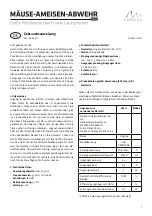
3.3 Making Connections:
Only use self-locking snap hooks and karabiners with this equipment. Only use connectors that
are suitable to each application. Ensure all connections are compatible in size, shape and strength. Do not use
equipment that is not compatible. Ensure all connectors are fully closed and locked.
Advance Safety connectors (snap hooks and karabiners) are designed to be used only as specied in each pro
duct's user's
instructions. See Figure 5 for inappropriate connections.
Advance Safety snap hooks and karabiners should not be connected:
A.
To a D-ring to which another connector is attached.
B.
In a manner that would result in a load on the gate.
C.
In a false engagement, where features that protrude from the
snap hook or karabiner catch on the anchor and without visual
conrmation seems to be fully engaged to the anchor point to
each other.
If the connecting element that a snap hook (shown) or
karabiner attaches to is undersized or irregular in shape, a
situation could occur where the connecting element applies a
force to the gate of the snap hook or karabiner. This force may
cause the gate (of either a self-locking or a non-locking snap
hook) to open, allowing the snap hook or karabiner to
disengage from the connecting point.
Figure 4 - Unintentional Disengagement (roll-out)
2. The gate presses against
the connecting Ring.
3. The gate opens allowing
the snap hook to slip off.
1. Force is applied to the
snap hook.
Small ring or other non-compatibly shaped element
C.
B.
A.
F.
E.
D.
G.
Figure 5 - Inappropriate Connections
3
3.0 SYSTEM REQUIREMENTS :
3.1 Compatibility Of Components:
Advance Safety equipment is designed for
use with Advance Safety approved components a n d subsystems only .
Substitutions or replacements made with non-approved components or
subsystems may jeopardize compatibility of equipment and may affect the
safety and reliability of the complete system.
E. Physical and Environmental Hazards:
Use of this equipment in areas
with physical or environmental hazards may require additional
precautions to reduce the possibility of injury to the user or damage to
the equipment. Hazards may include, but are not limited to; heat,
chemicals, corrosive environments, high voltage power lines, gases,
moving machinery, and sharp edges. Contact Advance Safety if you
have any questions about using this equipment where any
phy s ic a l o r environmental hazards exist.
F. Training:
This equipment must be used by persons who have been
properly trained in its correct application and use.
2.2
Refer to applicable local, state, and federal (OSHA) requirements governing
this equipment for more information on lanyards and associated system
components.
Figure 3
Free Fall Distance + Energy-Absorber Deceleration
Di Worker Safety Factor=20 Ft (6.1M)
Total 19 Ft.
from
Anchorage
Before
3 ft. Safety Factor
6 Ft. Length of
Energy-Absorbing
Lanyard
4 Ft. Deceleration
Distance
6 Ft. of Worker
After
6 Foot free Fall
Anchorage
This Application requires
a special EA lanyard
5 Ft. Deceleration
Distance
6 Ft. Length of
Energy-Absorbing
Lanyard
3 Ft. Safety Factor
6 Ft. Height
of Worker
Total
20 Ft.
from
Anchorage
After
Anchorage
Before
12 Foot free Fall
Anchorage
Calculating Total Fall Distances:
Total Fall Clearance below worker is calculated
from Anchorage Connection. Free Fall Distance
+ Energy Absorber Deceleration Distance +
Worker height + Safety Factor. Care must be
taken to ensure that the total fall distance is clear
of obstructions, such as equipment, to avoid
contact with a lower level.
Free Fall Distance + Energy Absorber
Deceleration Distance + Worker height +
Safety Factor = 19 Ft. (5.8M)
3.2 Compatibility Of Connectors:
Connectors are considered to be compatible
with connecting elements when they have been designed to work togethe r
in such a way that their sizes and shapes do not cause their gate m
e chanisms to
inadvertently open regardless of how they become oriented. Contact Advance Safety if you have any questions
about compatibility. Connectors (hooks, karabiners, and D-rings) must be capable of supporting at least 5,000 lbs.
(22.2 kN). Connectors must be compatible with the anchorage or other system components. Do not use equipment
that is not compatible. Non-compatible connectors may unintentionally disengage. See Figure 4. Connectors
must be compatible in size, shape, and strength. Self-locking snap hooks and karabiners are required by ANSI/ASSE
Z359.12 and OSHA.
Summary of Contents for Ansi 9206C-LE
Page 10: ...9 ...





























